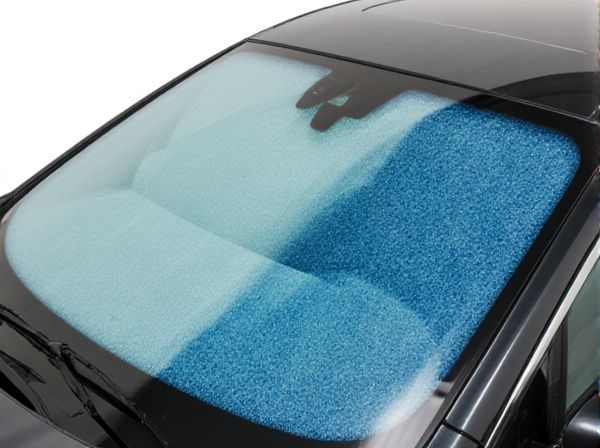
Photo illustration: Hydrophobic Coating Windshield vs Standard Coating Windshield
Hydrophobic coating windshields repel water more effectively than standard coatings, enhancing visibility and safety during rain. This advanced treatment causes water to bead up and roll off quickly, reducing the need for constant windshield wiper use. You benefit from clearer driving conditions and less frequent cleaning with hydrophobic coatings compared to traditional ones.
Table of Comparison
| Feature | Hydrophobic Coating Windshield | Standard Coating Windshield |
|---|---|---|
| Water Repellency | High - Causes water to bead and roll off | Low - Water tends to spread and stick |
| Visibility in Rain | Improved clarity, reduced glare | Standard clarity, prone to water streaks |
| Maintenance | Requires occasional reapplication | Minimal, standard cleaning |
| Durability | 6-12 months depending on usage | Long-lasting but no special water effects |
| Cost | Higher initial cost | Lower upfront cost |
| Safety | Enhanced driving safety during wet conditions | Standard safety performance |
Introduction to Windshield Coatings
Windshield coatings enhance visibility and safety by modifying the glass surface properties. Hydrophobic coatings repel water, causing it to bead and roll off quickly, improving vision during rain. Standard coatings provide basic protection against scratches and UV rays but lack advanced water-repellent features.
What is Hydrophobic Coating?
Hydrophobic coating on a windshield is a specialized treatment designed to repel water, causing raindrops to bead and roll off quickly, enhancing visibility and safety during wet conditions. Unlike standard coatings, which primarily protect against scratches and UV damage, hydrophobic coatings actively reduce water adhesion and improve windshield clarity by minimizing water streaks and buildup. This technology uses silicones or fluoropolymers to create a water-resistant surface, significantly improving driving performance in rainy weather.
Features of Standard Windshield Coatings
Standard windshield coatings primarily offer basic protection against scratches, UV rays, and minor abrasions, enhancing the glass's durability without significantly altering water repellency. These coatings often include anti-reflective layers that improve visibility and reduce glare under various lighting conditions. Unlike hydrophobic coatings, standard coatings do not actively repel water, leading to decreased visibility during heavy rain or adverse weather, necessitating increased reliance on windshield wipers.
Key Differences Between Hydrophobic and Standard Coatings
Hydrophobic coatings on windshields create a water-repellent surface that significantly improves visibility by causing rainwater to bead up and roll off quickly, unlike standard coatings that primarily offer basic protection without repelling water. Hydrophobic coatings typically enhance durability, resistance to dirt and grime, and reduce the need for frequent cleaning, whereas standard coatings focus mainly on scratch resistance and UV protection. The superior water shedding ability of hydrophobic coatings translates to improved driving safety in wet conditions compared to standard-coated windshields.
Water Repellency and Visibility Comparison
Hydrophobic coating windshields provide superior water repellency by causing water to bead up and roll off quickly, significantly enhancing visibility during rain compared to standard coatings that allow water to spread across the surface. This advanced water-shedding property reduces the need for frequent windshield wiper use, improving driver safety in wet conditions. Studies show hydrophobic coatings can increase visibility by up to 50% in adverse weather, making them a preferred choice over traditional standard coatings.
Durability and Longevity of Each Coating
Hydrophobic coating windshields provide superior durability by creating a water-repellent barrier that reduces the accumulation of dirt, grime, and water spots, extending the lifespan of the glass surface. Standard coating windshields, often relying on basic protective layers, tend to wear down faster due to exposure to environmental elements such as UV rays, road debris, and frequent cleaning. Hydrophobic coatings typically last between 12 to 24 months with proper maintenance, whereas standard coatings may require more frequent reapplication or replacement to maintain clarity and protection.
Maintenance Requirements for Both Types
Hydrophobic coating windshields require less frequent cleaning due to their water-repellent properties that prevent dirt and grime buildup, reducing the need for harsh chemicals and vigorous scrubbing. Standard coating windshields demand more regular maintenance to remove water spots, dust, and residues, as they lack the protective barrier against contaminants. Over time, hydrophobic coatings help maintain clearer visibility with minimal upkeep, while standard coatings may require increased effort to sustain clarity and performance.
Impact on Driving Safety and Comfort
Hydrophobic coating windshields enhance driving safety by causing water to bead and roll off quickly, improving visibility during rain and reducing glare from water droplets. These coatings also promote comfort by minimizing the need for constant wiper use and reducing smear marks that obstruct the driver's view. Standard coating windshields lack these water-repellent properties, often resulting in poorer visibility and increased driver fatigue under wet conditions.
Cost and Value Analysis
Hydrophobic coating windshields generally incur higher upfront costs compared to standard coatings due to advanced water-repellent materials and application processes. Despite this initial investment, hydrophobic coatings offer enhanced visibility during rain, reducing the need for frequent windshield wiper use and potential maintenance expenses. Over time, the improved safety and durability provide greater value, making hydrophobic coatings a cost-effective choice for drivers seeking long-term benefits.
Which Windshield Coating is Best for You?
Hydrophobic coating windshields repel water, improving visibility during rain by causing droplets to bead and roll off quickly, making them ideal for drivers frequently facing wet conditions. Standard coatings provide basic protection against scratches and UV rays but lack the advanced water-repellent properties of hydrophobic films. Choosing the best windshield coating depends on your driving environment; hydrophobic coatings offer superior clarity in rain, while standard coatings suffice for everyday use with less exposure to harsh weather.
 caratoz.com
caratoz.com